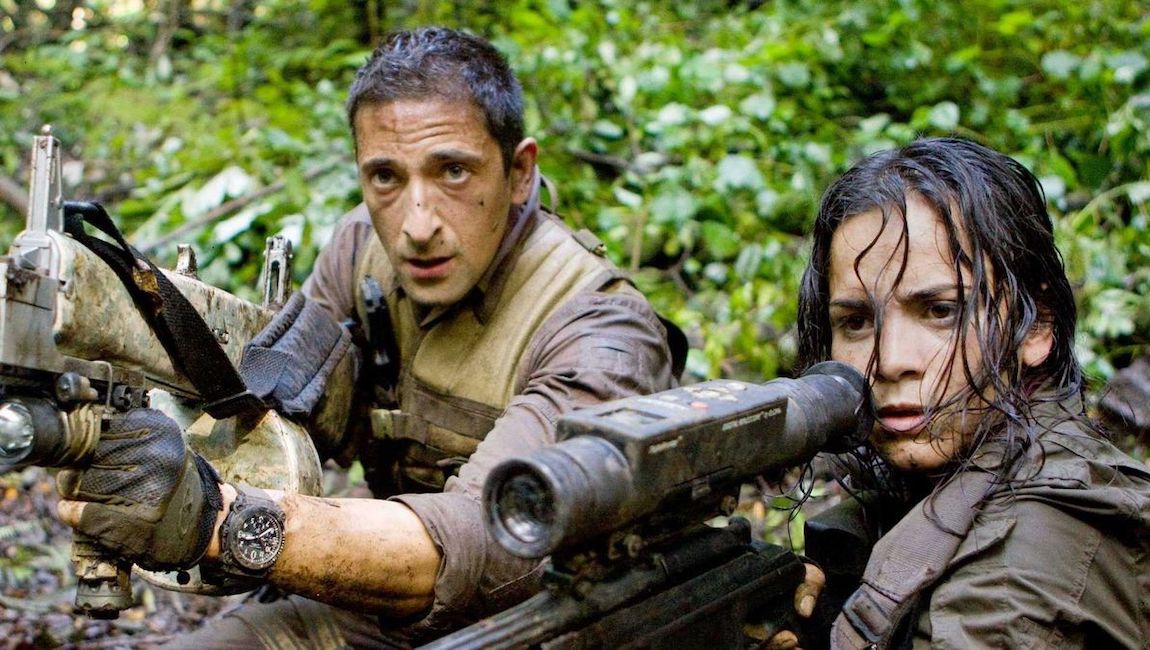Time has had a unique effect on John McTiernan’s 1987 sci-fi action classic Predator. While its status as a genre benchmark has solidified over the years, its fan base has gradually forgotten that the film is deeply, deeply silly. After all, it’s about Arnold Schwarzenegger and a team of spec-ops triggermen getting picked off in the Amazon jungle by a crab monster from outer space. It is, at its heart, an ’80s action movie, full of dopey one-liners, thin-but-utilitarian character sketches, and of course oodles of gratuitous violence. Yet McTiernan’s confident, wide-shot camerawork and his extremely charismatic cast conspire to create a thrilling summer movie experience. It’s important to note that, despite Stan Winston’s iconic and incredible design, the “character” of the Predator isn’t what gives the film its longevity. To make a somewhat dubious comparison, nobody loves Jaws because they want to find out what happens to the shark.
Nimrod Antal and Robert Rodriguez, who respectively directed and produced the new sequel, Predators, appear to be in on it all. This latest installment spends more than half of its running time following a globally diverse group of kidnapped bad-asses (a mercenary, a CIA agent, a Yakuza, a Russian soldier, etc.) as they traipse their way around a strange jungle planet, brought there by the titular alien hunters as game. As with the original film, the first half of Predators coasts by on the charisma of its cast, led by a buffed-up Adrien Brody. Rodriguez stock-player Danny Trejo appears, as do Laurence Fishburne, Topher Grace, and Walton Goggins (recently seen on TV’s Justified) as a tweaked-out death-row inmate with a penchant for filthy non-sequiturs. Brody manages to convey a strangely appropriate amount of gravitas as a career mercenary who feels he understands the motivations of his alien stalkers, while Fishburne and Goggins get the movie’s best moments, both playing gleefully unhinged weirdoes coping with their ridiculous circumstances.
The titular monster is barely glimpsed until well into the second act. As McTiernan did in the first film, Antal keeps the Predator in the background for a long time. That’s a double-edged sword, though. While we get to spend time with our wisecracking characters, we all know where the story’s going and what the alien looks like and wants, which cuts the suspense down. But the movie isn’t in the scare business. Rather, Predators is about 80% fan service, consisting mostly of callbacks to the original and “wouldn’t this be cool?” scenes like the one in which a shirtless Yakuza soldier takes on a Predator with a samurai sword. Of course, it’s a patently absurd thing to behold, but it’s a great moment of geek fun — exactly the sort of thing fans of the franchise have been imagining for almost two decades now. The other 20% of the movie is devoted to the requisite monster fights, bloody limb removals, and a very memorable de-spining.
Antal, much like McTiernan, traffics heavily in wide shots of action and, conversely, close-ups on faces, lending the quiet scenes a sweaty urgency and the mayhem some much-needed geography. The practical jungle sets and general lack of CG enhancement to the special effects go a very, very long way to put the viewer in a nostalgic, forgiving frame of mind. So let it not be said that Predators doesn’t know its audience. Therein lies an odd problem, though. Predators is not by any stretch of the imagination a “good” film. It exists primarily to scratch a certain itch, which it does very well. Those without a vested interest in genre filmmaking in general and action films, in particular, will probably find it stupid and maybe even boring. But those with a fondness for this kind of shaggy entertainment will find that it hits the spot, dutifully updating a beloved artifact without succumbing to the current trend of draining every goofy genre hook of much-needed humor







